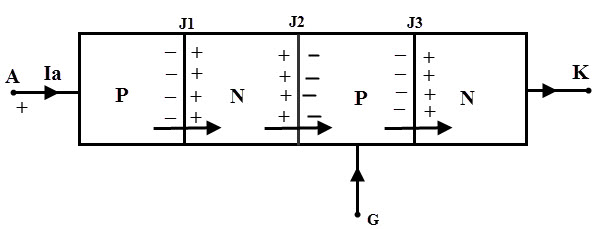Introduction to SCR
Introduction
The Silicon Controlled Rectifier (SCR) is the most important and mostly used member of the thyristor family. SCR can be used for different applications like rectification, regulation of power and inversion, etc. Like a diode, SCR is a unidirectional device that allows the current in one direction and opposes in another direction.
SCR is a three terminal device; anode, cathode and gate as shown in figure. SCR has built in feature to turn ON or OFF and its switching is controlled by biasing conditions and gate input terminal.
This results in varying the average power delivered at the load , by varying the ON periods of the SCR. It can handle several thousands of voltages and currents. SCR symbol and its terminals are shown in figure.
Construction of Silicon Controlled Rectifier
The SCR is a four layer and three terminal device. The four layers made of P and N layers, are arranged alternately such that they form three junctions J1, J2 and J3. These junctions are either alloyed or diffused based on the type of construction.
The outer layers (P and N-layers) are heavily doped whereas middle P and N-layers are lightly doped. The gate terminal is taken at the middle P-layer, anode is from outer P- layer and cathode is from N- layer terminals. The SCR is made of silicon because compared to germanium leakage current in silicon is very small.
To manufacture the SCR, three types of constructions are used, namely the planar type, Mesa type and Press pack type. For low power SCRs, planar construction is used where all the junctions in an SCR are diffused. In mesa type construction, junction J2 is formed by diffusion method and thereby outer layers are alloyed to it.
This construction is mainly used for high power Silicon Controlled Rectifiers. To provide high mechanical strength, the SCR is braced with plates made up of either molybdenum or tungsten. And one of these plates is soldered to a copper stud which is further threaded to connect the heat sink.




Comments
Post a Comment